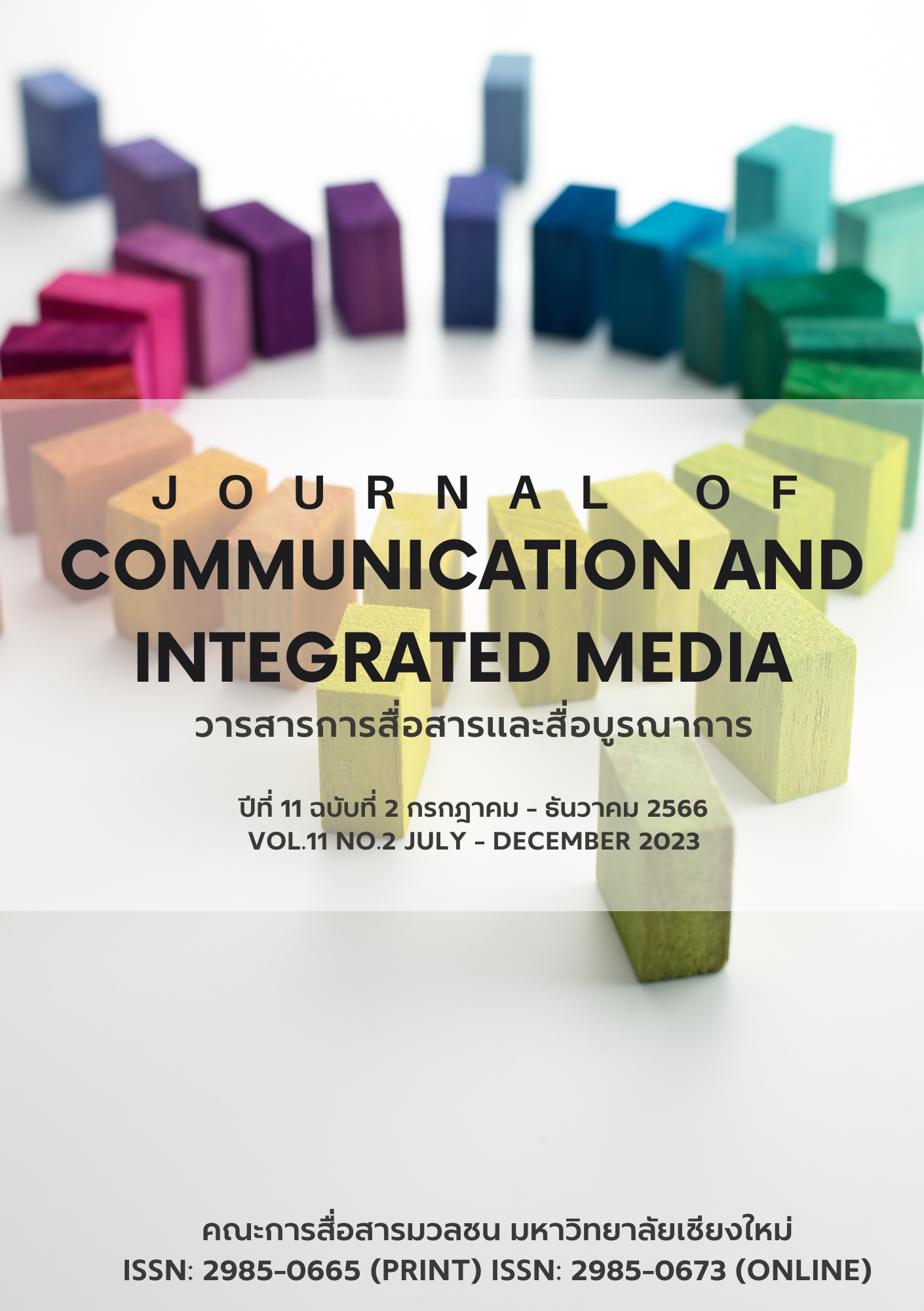Situation, Impacts, and Guidelines for Appropriate Television Advertising
Main Article Content
Abstract
This research aims to study the situation of television advertising, the impacts of television advertising, and guidelines for appropriate television advertising. The in-depth interview was applied to 30 stakeholders. Findings indicated that the current situation of the television program business had changed due to the change of broadcasting system from analog to the digital system, the growth of online media, and the audience’s behavior. Consequently, the income of entrepreneurs decreased. Thus, they must expand the channel to
maximize their earnings. The primary income was from advertising, tie-in advertising, and television shopping programs. The advertising had positive and negative impacts on the individual, institutes, and society. Further, the guidelines for television advertising revealed that the tie-in advertising and television shopping programs should set the appropriate presentation model founded on the appropriateness and product quality, content/ program compatibility, the volume of presentation, no purchasing promotion, text or symbol during the display of the tie-in advertising, and the fact but not the user review. Each television program had different suggestions on the control.
Article Details

This work is licensed under a Creative Commons Attribution-NonCommercial-NoDerivatives 4.0 International License.
ลิขสิทธ์ที่ผู้เขียนบทความต้องยอมรับ
References
กมลรัฐ อินทรทัศน์. (2557). ทฤษฎีการสื่อสารและเทคโนโลยีสารสนเทศ. ใน กำจร หลุยยะพงศ์ (บ.ก.), ปรัชญานิเทศศาสตร์และทฤษฎีการสื่อสาร. สำนักพิมพ์มหาวิทยาลัยสุโขทัยธรรมธิราช.
กรรณิการ์ สุวรรณมณี. (2562). การให้บริการทีวีชอปปิง: เครื่องมือในการแข่งขันของผู้ประกอบการจริงหรือ?. รายงานวิเคราะห์พฤติกรรมการแข่งขันในกิจการกระจายเสียงและกิจการโทรทัศน์ Q1-2019. สำนักงานคณะกรรมการกิจการกระจายเสียง กิจการโทรทัศน์ และกิจการโทรคมนาคมแห่งชาติ.
กาญจนา แก้วเทพ และ สมสุข หินวิมาน. (2551). สายธารนักคิดทฤษฎีเศรษฐศาสตร์การเมืองกับสื่อสารศึกษา. ภาพพิมพ์.
กีรติกานต์ วันถนอม. (2539). การวิเคราะห์รูปแบบ เนื้อหาและปัจจัยที่มีบทบาทต่อการสร้างสรรค์เพลงโฆษณา [วิทยานิพนธ์นิเทศศาสตรมหาบัณฑิต].จุฬาลงกรณ์มหาวิทยาลัย.
จารุวรรณ นิธิไพบลูย์, สันทัด ทองรินทร์, และ วิทยาธร ท่อแก้ว. (2559). การพัฒนารายการโทรทัศน์เพื่อผู้สูงอายุ. วารสารบัณฑิตศึกษา มหาวิทยาลัยราชภัฏวไลยอลงกรณ์ในพระบรมราชูปถัมภ์, 10(2), 21-39.
ณัฐกานต์ แก้วขำ. (2564). บทบาทของอุตสาหกรรมสื่อโทรทัศน์ในภูมิทัศน์ของสื่อใหม่ภายใต้ระบบเศรษฐกิจดิจิทัล. วารสารนิเทศศาสตร์, 39(1), 107-119.
ณัฐวรรณ เจริญรัตนพรชัย. (2556). มาตรการทางกฎหมายในการคุ้มครองผู้บริโภคจากการโฆษณาที่แฝงมาในรูปของบทวิจารณ์สินค้าและบริการผ่านระบบอินเทอร์เน็ต [วิทยานิพนธ์นิติศาสตรมหาบัณฑิต]. จุฬาลงกรณ์มหาวิทยาลัย.
บุณยาพร กิตติสุนทโรภาศ. (2564, ม.ป.ป.). ทีวีดิจิทัล ทำเลทองของโฆษณาในยุคโควิด-19. ฉลาดซื้อนิตยสารออนไลน์. https://chaladsue.com/article/3873/เรื่องเด่น-ฉบับที่-249-ทีวีดิจิทัล-ทำเลทองของโฆษณา
แบรนด์บุฟเฟต์. (2565, 9 พฤษภาคม). 5 เหตุผล “ทีวีโฮมช้อปปิ้ง” ยังไปต่อได้ ในวันที่ใครๆ ก็ซื้อของออนไลน์. https://www.brandbuffet.in.th/2022/05/5-keys-for-the-growth-of-tv-home-shopping/
ผู้จัดการออนไลน์. (2565, 28 พฤศจิกายน). สื่อออนไลน์ขึ้นที่ 2 จ่ายแพงกว่าทีวี จบปี 65 คาดทะลุ 2.6 หมื่นล. https://mgronline.com/business/detail/9650000112933
พรณรงค์ พงษ์กลาง. (2560). การบริหารจัดการสื่อโทรทัศน์ในศตวรรษที่ 21. วารสารวิชาการสถาบันอุดมศึกษาเอกชนแห่งประเทศไทย, 23(1), 90-102.
พรทรัพย์ ฉัตรศิริสุข. (2561). การเปิดรับความน่าเชื่อถือของรายการโฮมชอปปิงในโทรทัศน์ดิจิทัลและการตัดสินใจซื้อของผู้บริโภค [วิทยานิพนธ์นิเทศศาสตรมหาบัณฑิต]. จุฬาลงกรณ์มหาวิทยาลัย.
โพสต์ทูเดย์. (2565, 27 พฤษภาคม). ‘ทีวีโฮมชอปปิง’ตอบโจทย์คนไทยช่วงโควิด ดันมูลค่าซื้อขายแตะ 1.6 หมื่นล้าน. https://www.posttoday.com/economy/news/684266
รณชัย แก้วดู และ มนวิภา วงรุจิระ. (2563). การบริหารรายได้ของสื่อทีวีดิจิทัลท่ามกลางการเปลี่ยนแปลงของภูมิทัศน์สื่อ. วารสารนิเทศศาสตร์ มสธ. ,10(1), 68-85.
วิทยาลัยพาณิชยศาสตร์ มหาวิทยาลัยบูรพา. (2562). โครงการศึกษารูปแบบและวิธีการโฆษณาเพื่อจัดทำข้อเสนอแนะต่อการกำกับดูแลการกระทำที่เป็นการเอาเปรียบผู้บริโภคในกิจการกระจายเสียงและโทรทัศน์. สำนักงานคณะกรรมการกิจการกระจายเสียง กิจการโทรทัศน์และกิจการโทรคมนาคมแห่งชาติ. http://bcp.nbtc.go.th/uploads/items/attachments/a1d33d0dfec820b41b54430b50e96b5c/_402373557f9d12b0df24cb8e59ccc3a6.pdf
วีรพงษ์ พวงเล็ก. (2547). การสำรวจทัศนคติของประชาชนในเขตกรุงเทพมหานครที่มีต่อการโฆษณาสินค้าแฝงในละครโทรทัศน์ [วิทยานิพนธ์วารสารศาสตรมหาบัณฑิต]. มหาวิทยาลัยธรรมศาสตร์.
ศญานันท์ ทองคล้าย. (2551). การรับรู้และการจดจำโฆษณาแฝงที่ปรากฏในภาพยนตร์ไทย [วิทยานิพนธ์วารสารศาสตรมหาบัณฑิต]. มหาวิทยาลัยธรรมศาสตร์.
สถาบันวิจัยและให้คำปรึกษาแห่งมหาวิทยาลัยธรรมศาสตร์. (2559). ศึกษาผลกระทบและแนวทางการพัฒนารูปแบบและเนื้อหารายการโทรทัศน์ภาคพื้นดินในระบบดิจิตอลในประเทศไทยหลังการเปลี่ยนผ่าน. TU-RAC. https://turac.tu.ac.th/wp-content/uploads/2022/10/2562A00377.pdf
สมาคมโฆษณาแห่งประเทศไทย. (ม.ป.ป.) ETHICS จรรยาบรรณแห่งวิชาชีพโฆษณา. http://www.adassothai.com/index.php/main/about/ethic
สรีรโรจน์ สุกมลสันต์, วรรณา ศรีวิริยานุภาพ, และ วิทยา กุลสมบูรณ์. (2557). การโฆษณาในรายการโทรทัศน์สำหรับเด็ก: ข้อเสนอแนะเชิงนโยบายในการกำกับดูแล. วารสารวิจัยระบบสารธารณสุข, 8(2), 210-22.
สิริกร เสือเหลือง และ สุรสิทธิ์ อุดมธนวงศ์. (2563). อิทธิพลของบุคคลที่มีชื่อเสียงและการรับรู้โฆษณาแฝงผ่านการตระหนักรู้ตราสินค้าที่ส่งผลต่อความตั้งใจซื้อรถจักรยานยนต์ของผู้ชมซีรีส์ออนไลน์ในเขตกรุงเทพมหานคร. วารสารวิจัยวิทยาการจัดการ มหาวิทยาลัยราชภัฏสุรินทร์, 4(2), 67-80.
สุภัสสร หาญลำยวง และ เฉลิมพร เย็นเยือก. (2564). การปรับตัวและการสร้างนวัตกรรมด้านกลยุทธ์ของธุรกิจสื่อโทรทัศน์ในยุคทีวีดิจิตอล. วารสารสมาคมนักวิจัย, 26(1), 1-15.
สุมนมาศ คำทอง. (2560). การวิเคราะห์ความอยู่รอดของอุตสาหกรรมทีวีดิจิทัล. วารสารวิชาการ กสทช, 2(2017), 136-157.
องอาจ สิงห์ลำพอง. (2560). การบริหารจัดการรายการโทรทัศน์ในยุคไทยแลนด์ 4.0. วารสารนิเทศศาสตร์ธุรกิจบัณฑิต, 11(2), 209-245.
อาภาพร อุดมพืช. (2553). การวิเคราะห์ลักษณะโฆษณาแฝงที่ปรากฏในรายการโทรทัศน์ไทย. วารสารวิชาการมหาวิทยาลัยฟาร์อีสเทอร์น, 3(2), 82-90.
อารดา ทางตะคุ. (2562). พฤติกรรมการอุดหนุนบริการ: กรณีศึกษาช่อง PPTV. รายงานวิเคราะห์พฤติกรรมการแข่งขันในกิจการกระจายเสียงและกิจการโทรทัศน์ Q1-2019. สำนักงานคณะกรรมการกิจการกระจายเสียง กิจการโทรทัศน์ และกิจการโทรคมนาคมแห่งชาติ.
Balasubramanian, S. K. (1994). Beyond advertising and publicity: Hybrid message and public policy issues. Journal of Advertising, 23, 29-46.
Belch, G. E., & Belch, M. A. (2018). Advertising and promotion: An integrated marketing communications perspective (11th ed.). McGraw-Hill.
Campbell, A. J. (1999). Self-regulation and the media. Federal Communications Law Journal, 51(3), 711-772.
Cowley, E. & Barron, C. (2008). When product placement goes wrong. Journal of Advertising; 37(1), 89-98.
Cunningham, P. H. (1999). Ethics of advertising the advertising business. Sage.
Drumwright, E. M., & Murphy, E. P. (2009). The current state of advertising ethics. The Journal of Advertising, 38(1), 83-105.
Furnémont, J. F. & Smokvina, T. K. (2017). European co-Regulationpractices in the media. Council of Europe. https://rm.coe.int/european-co-regulation-practices-in-the-media/16808c9c74
Karrh, A. J. (1998). Brand placement: A review. Journal of Current Issues and Research in Advertising, 20(2), 31-49.
Karrh, A.J., Fitrh, K.T., & Callison. C. (2001). Audience attitudes towards brand placement: Singapore and the United States. International Journal of Advertising, 20(1), 3-24.
Karrh, A. J., Mckee, B. K., & Pardun, J. C. (2003). Practitioners’ evolving views on product placement effectiveness. Journal of Advertising Research, June 2003, 138-147.
Marketeer. (2021, December 15). TV – Streaming 2022 กับบริบทผู้บริโภคที่เปลี่ยนไป. https://marketeeronline.co/archives/244532
Ofcom. (2023). Product placement on TV. https://www.ofcom.org.uk/tv-radio-and-on-demand/advice-for-consumers/television/product-placement-on-tv
Puppis, M. (2010). Media Governance: A new concept for the analysis of media policy and regulation. Communication, Culture &Critique, 3(2010), 134–149.
Russell, C. A., & Belch, M. (2005). A managerial investigation into the product placement industry. Journal of Advertising Research, 45(1), 73–92.
Smit, E., Reijmersdal, V. E., & Neijens, P. (2009). Today’s practice of brand placement and the industry behind it. International Journal of Advertising, 28(5), 761-782.gov.au/advertising-rules-broadcasters
The Australian Communications and Media Authority. (2019). Advertising rules for broadcasters. https://www.acma.gov.au/advertising-rules-broadcasters
Wenner, L. A. (2004). On the ethics of products placement in media entertainment. Journal of Promotion Management, 10(1/2), 101-132.

